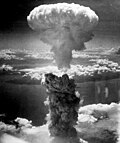
Heavy water is a form of water whose hydrogen atoms are all deuterium rather than the common hydrogen-1 isotope that makes up most of the hydrogen in normal water. The presence of the heavier hydrogen isotope gives the water different nuclear properties, and the increase in mass gives it slightly different physical and chemical properties when compared to normal water.

The Manhattan Project was a program of research and development undertaken during World War II to produce the first nuclear weapons. It was led by the United States in collaboration with the United Kingdom and with support from Canada. From 1942 to 1946, the project was under the direction of Major General Leslie Groves of the U.S. Army Corps of Engineers. Nuclear physicist J. Robert Oppenheimer was the director of the Los Alamos Laboratory that designed the bombs. The Army component was designated the Manhattan District, as its first headquarters were in Manhattan; the name gradually superseded the official codename, Development of Substitute Materials, for the entire project. The project absorbed its earlier British counterpart, Tube Alloys. The Manhattan Project grew rapidly and employed nearly 130,000 people at its peak and cost nearly US$2 billion. Over 80 percent of the cost was for building and operating the plants that produced the fissile material for the weapons. Research and production took place at more than 30 sites across the United States, the United Kingdom, and Canada.

The Hanford Site is a decommissioned nuclear production complex operated by the United States federal government on the Columbia River in Benton County in the U.S. state of Washington. It has also been known as Site W and the Hanford Nuclear Reservation. Established in 1943 as part of the Manhattan Project, the site was home to the Hanford Engineer Works and B Reactor, the first full-scale plutonium production reactor in the world. Plutonium manufactured at the site was used in the first atomic bomb, which was tested in the Trinity nuclear test, and in the Fat Man bomb used in the bombing of Nagasaki.
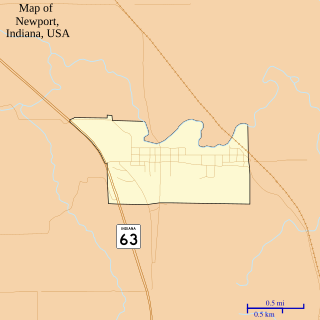
Newport is a town in Vermillion Township, Vermillion County, in the U.S. state of Indiana. The population was 515 at the 2010 census. The town is the county seat of Vermillion County.

The Metallurgical Laboratory was a scientific laboratory at the University of Chicago that was established in February 1942 to study and use the newly discovered chemical element plutonium. It researched plutonium's chemistry and metallurgy, designed the world's first nuclear reactors to produce it, and developed chemical processes to separate it from other elements. In August 1942 the lab's chemical section was the first to chemically separate a weighable sample of plutonium, and on 2 December 1942, the Met Lab produced the first controlled nuclear chain reaction, in the reactor Chicago Pile-1, which was constructed under the stands of the university's old football stadium, Stagg Field.
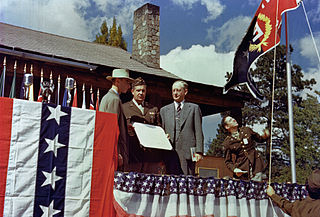
The Manhattan Project was a research and development project that produced the first atomic bombs during World War II. It was led by the United States with the support of the United Kingdom and Canada. From 1942 to 1946, the project was under the direction of Major General Leslie Groves of the US Army Corps of Engineers. The Army component of the project was designated the Manhattan District; "Manhattan" gradually became the codename for the entire project. Along the way, the project absorbed its earlier British counterpart, Tube Alloys. The Manhattan Project began modestly in 1939, but grew to employ more than 130,000 people and cost nearly US$2 billion. Over 90% of the cost was for building factories and producing the fissionable materials, with less than 10% for development and production of the weapons.

The S-50 Project was the Manhattan Project's effort to produce enriched uranium by liquid thermal diffusion during World War II. It was one of three technologies for uranium enrichment pursued by the Manhattan Project.
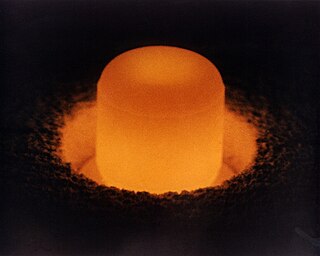
Plutonium-238 is a radioactive isotope of plutonium that has a half-life of 87.7 years.
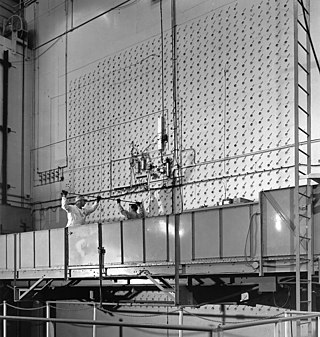
The X-10 Graphite Reactor is a decommissioned nuclear reactor at Oak Ridge National Laboratory in Oak Ridge, Tennessee. Formerly known as the Clinton Pile and X-10 Pile, it was the world's second artificial nuclear reactor, and the first designed and built for continuous operation. It was built during World War II as part of the Manhattan Project.

"Thin Man" was the code name for a proposed plutonium gun-type nuclear bomb that the United States was developing during the Manhattan Project. Its development was abandoned when it was discovered that the spontaneous fission rate of nuclear reactor-bred plutonium was too high for use in a gun-type design due to the high concentration of the isotope plutonium-240 in the plutonium produced at the Clinton Engineer Works.
The Atomic Heritage Foundation (AHF) is a nonprofit organization originally based in Washington, DC, dedicated to the preservation and interpretation of the Manhattan Project, the Atomic Age, and its legacy. Founded by Cynthia Kelly in 2002, the Foundation's stated goal is, "to provide the public not only a better understanding of the past but also a basis for addressing scientific, technical, political, social and ethical issues of the 21st century." AHF works with Congress, the Department of Energy, the National Park Service, state and local governments, nonprofit organizations and the former Manhattan Project communities to preserve and interpret historic sites and develop useful and accessible educational materials for veterans, teachers, and the general public. In June 2019, the Atomic Heritage Foundation and the National Museum of Nuclear Science & History signed an agreement that granted stewardship of the Atomic Heritage Foundation website and all of the AHF's physical collections to the museum. The Atomic Heritage Foundation website is now run by the National Museum of Nuclear Science & History. Additionally, the museum now houses the Atomic Heritage Foundation's physical collections which have been integrated into the Nuclear Museum's own collection.

Franklin Thompson Matthias was an American civil engineer who directed the construction of the Hanford nuclear site, a key facility of the Manhattan Project during World War II.

The Montreal Laboratory in Montreal, Quebec, Canada, was established by the National Research Council of Canada during World War II to undertake nuclear research in collaboration with the United Kingdom, and to absorb some of the scientists and work of the Tube Alloys nuclear project in Britain. It became part of the Manhattan Project, and designed and built some of the world's first nuclear reactors.

Trail is a city in the West Kootenay region of the Interior of British Columbia, Canada. It was named after the Dewdney Trail, which passed through the area. The town was first called Trail Creek or Trail Creek Landing, and the name was shortened to Trail in 1897.

The bismuth-phosphate process was used to extract plutonium from irradiated uranium taken from nuclear reactors. It was developed during World War II by Stanley G. Thompson, a chemist working for the Manhattan Project at the University of California, Berkeley. This process was used to produce plutonium at the Hanford Site. Plutonium was used in the atomic bomb that was used in the atomic bombing of Nagasaki in August 1945. The process was superseded in the 1950s by the REDOX and PUREX processes.

The Clinton Engineer Works (CEW) was the production installation of the Manhattan Project that during World War II produced the enriched uranium used in the 1945 bombing of Hiroshima, as well as the first examples of reactor-produced plutonium. It consisted of production facilities arranged at three major sites, various utilities including a power plant, and the town of Oak Ridge. It was in East Tennessee, about 18 miles (29 km) west of Knoxville, and was named after the town of Clinton, eight miles (13 km) to the north. The production facilities were mainly in Roane County, and the northern part of the site was in Anderson County. The Manhattan District Engineer, Kenneth Nichols, moved the Manhattan District headquarters from Manhattan to Oak Ridge in August 1943. During the war, Clinton's advanced research was managed for the government by the University of Chicago.
The Ames Project was a research and development project that was part of the larger Manhattan Project to build the first atomic bombs during World War II. It was founded by Frank Spedding from Iowa State College in Ames, Iowa as an offshoot of the Metallurgical Laboratory at the University of Chicago devoted to chemistry and metallurgy, but became a separate project in its own right. The Ames Project developed the Ames Process, a method for preparing pure uranium metal that the Manhattan Project needed for its atomic bombs and nuclear reactors. Between 1942 and 1945, it produced over 1,000 short tons (910 t) of uranium metal. It also developed methods of preparing and casting thorium, cerium and beryllium. In October 1945 Iowa State College received the Army-Navy "E" Award for Excellence in Production, an award usually only given to industrial organizations. In 1947 it became the Ames Laboratory, a national laboratory under the Atomic Energy Commission.
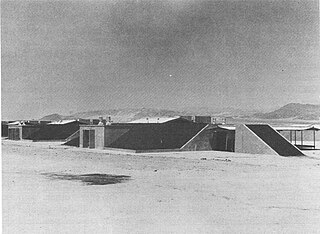
The Salt Wells Pilot Plant was a facility established by the Manhattan Project at the Naval Ordnance Test Station (NOTS) at Inyokern, California, where non-nuclear explosive components of nuclear weapons were manufactured. The first explosives were melted, mixed and poured on 25 July 1945. Between 1945 and 1954, it manufactured explosive components of the Fat Man, Mark 4, Mark 5 and Mark 12 nuclear bombs. The Salt Wells Pilot Plant also helped design, equip, and train workers for the Burlington AEC Plant in Iowa and the Pantex Plant in Texas. The Salt Wells Pilot Plant closed on 30 June 1954.

High Explosive Research (HER) was the British project to develop atomic bombs independently after the Second World War. This decision was taken by a cabinet sub-committee on 8 January 1947, in response to apprehension of an American return to isolationism, fears that Britain might lose its great power status, and the actions by the United States to withdraw unilaterally from sharing of nuclear technology under the 1943 Quebec Agreement. The decision was publicly announced in the House of Commons on 12 May 1948.

The Hanford Engineer Works (HEW) was a nuclear production complex in Benton County, Washington, established by the United States federal government in 1943 as part of the Manhattan Project during World War II. It was home to the B Reactor, the first full-scale plutonium production reactor. Plutonium manufactured at the HEW was used in the atomic bomb detonated in the Trinity test in July 1945, and in the Fat Man bomb used in the atomic bombing of Nagasaki in August 1945. The HEW was commanded by Colonel Franklin T. Matthias until January 1946, and then by Colonel Frederick J. Clarke.





















